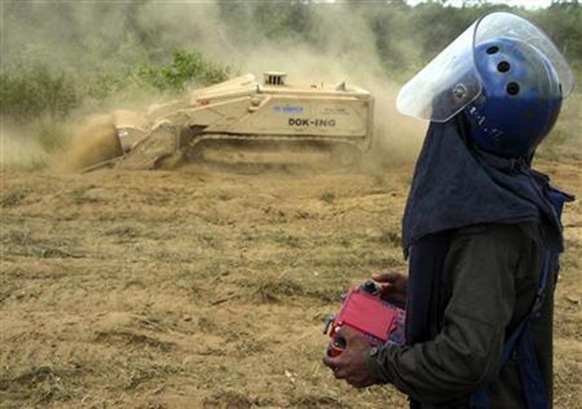 Post-war Sri Lanka will need another decade to clear the half million landmines which lie buried under swathes of agricultural and forest land and around villages in the north of the island nation, the head of a demining group said.
Post-war Sri Lanka will need another decade to clear the half million landmines which lie buried under swathes of agricultural and forest land and around villages in the north of the island nation, the head of a demining group said.
The country is in its third year of peace after government forces defeated the separatist Tamil Tigers in a civil war which lasted a quarter of a century, killing and injuring tens of thousands of people.
But as people who fled the fighting return home to rebuild their lives, they still face the threat of anti-personnel mines and unexploded ordnance (UXOs) like bombs, rockets and hand grenades left behind by the Tamil Tigers and Sri Lankan army.
"Based on our current clearance rates, there are perhaps half a million landmines that need to be cleared," said Nigel Robinson, country head of the Swiss Foundation for Mine Action (FSD), which has cleared 60,000 mines since 2002.
"So it’ll perhaps take 10 years for Sri Lanka to become fully mine-impact free, assuming the current capacity of de-miners can be maintained," he told AlertNet in an interview from a clearing in a minefield in the northwest district of Mannar.
The FSD has 750 deminers clearing the mines, aided by other specialist groups. There are no official figures on exactly how many mines and UXOs were used during the war, although some reports suggest more than a million mines were planted during the 25 years.
"EXTENSIVE USE"
The Land mine and Cluster Munition Monitor (LCMM) says the Sri Lankan government, which is not a signatory of the Land mine Ban Treaty, and the Tigers "made extensive use of landmines."
These included belts of Pakistani-made P4 MK1 mines laid by the army and long defensive lines of mines and booby-traps manufactured by the separatists.
The Tigers also left extensive "nuisance" mines in the north — particularly in areas of intense fighting and often planted as its fighters retreated in the face of the army’s advance.
Fortunately, casualties have been low despite the high mine density in parts of the country. The LCMM says there were 38 injuries and deaths in 2009 compared to 78 in 2008.
"Casualties in Sri Lanka are relatively low compared to other places in the world, like Afghanistan where you have around 900 casualties per year," said Robinson, adding that most were due to people doing "high-risk" activities like burning undergrowth to clear their farmland.
Mine risk awareness and the fact that the Tigers’ homemade mines became less effective over time helped keep casualty figures low in the Indian Ocean island, he said.
(For updates you can share with your friends, follow TNN on Facebook and Twitter )
